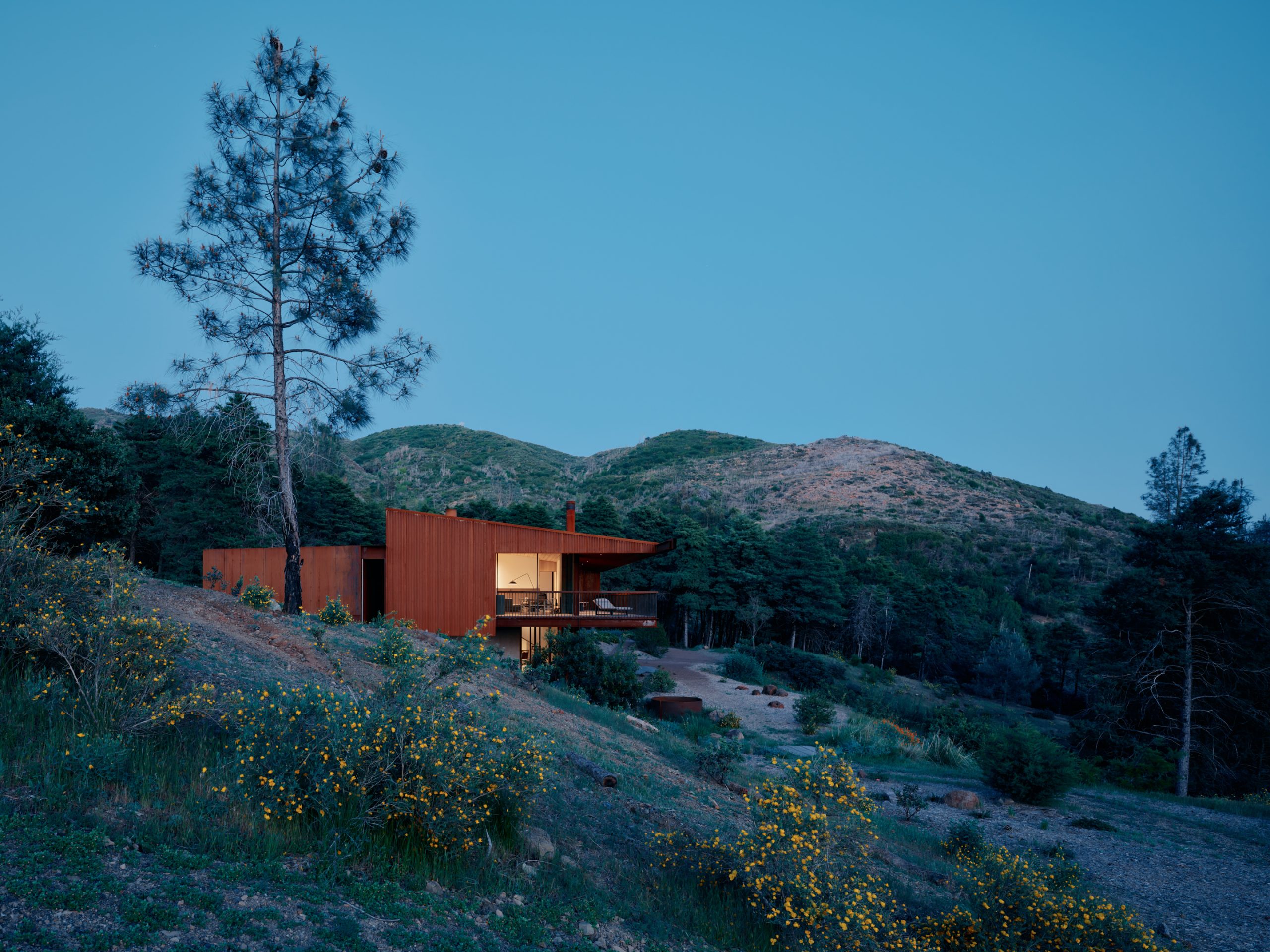Reimagined following the Kincade Fire by Faulkner Architects, this off-grid dwelling preserved the surviving concrete foundations and walls. The new weathering steel, fire-resilient protective form respects the site’s earthen tones and historic mining past.
This home is out in a rural area, about 40 minutes Northeast from downtown Healdsburg. Please download directions before heading out. Give yourself enough time to get there, and to other events afterwards. If you are traveling from afar, pack a snack and water for the drive!
Architecture and Interiors: Faulkner Architects
Contractor: @annadelbuildersinc
Structural: Strandberg Engineering
MEP: Sugar Pine
Landscape: Terremoto
Civil: Summit Engineering Inc
Lighting: O-LLC
ABOUT THE PROJECT:
In a remote setting accessed by a winding former stagecoach road, the original off-grid house was destroyed in the 2019 Kincade Fire. The pioneering resourcefulness of the clients allowed them to embrace an alternative, landscape-driven lifestyle, that follows the spirit of the nearby original historic Pine Flat community – a boomtown that flourished in the Mayacamas Mountains during the quicksilver and mercury rush in the 1870s.
A brief and program was developed with key aims that included a durable, low- maintenance, long-lifecycle, off-grid, wildfire-resilient house. Robust materials, a fire-resistive shell, sliding ember screens, and exterior sprinklers above decks mitigate this concern. Accessibility as the clients’ age was important. The design integrates an entry ramp, wheelchair maneuvering clearances, pre-framed elevator location, and maintains the primary bedroom on the same level as the kitchen, dining, and living spaces.

Reuse of existing foundation and walls for 90% of the project’s concrete retained existing embodied energy and limited additional excavation. A rectangular shed form inhabits the old angular foundation. Like stepping on a leaf, portions extending beyond the outline of the new rectangle are utilized for a sculptural entry step as well as a glazed light well. The preserved concrete foundation is half buried into the hillside, juxtaposed with the outstretched protective structure elevated above. The simple form parallels the direction of the ridgeline, existing as a quiet presence in the wildland landscape. A new concrete chimney mass anchors the main floor, setting a view of the fire within the landscape that recalls the danger. An entry ramp extends outward as an expressive form toward the west hillside. The artesian water basin fosters a visual and poetic dialogue to honor the site’s spring water. Remoteness led to materials taking on a precious quality to limit waste.
The off-grid site utilities support a home that embraces passive survivability. The existing solar PV array was replaced with upgraded panels, inverters, and batteries. 100% of stormwater is captured and retained on site. A cantilevered gutter flows into a steel basin and diverts runoff to a vegetated bioretention area before flowing down to a retention pond that serves as a backup firefighting water source. Spring-fed wells provide all water usage including a dedicated tank for the fire hydrant and sprinkler system. The concrete basin captures water after it is harnessed by a Pelton wheel for supplementary hydroelectric power, offering a continually refreshed basin for cooling dips. Wastewater is treated in a repaired septic field.
This project exemplifies how residential architecture can transcend aesthetic considerations. The house is a tool for living shaped by the needs of the site. As we continue to expand into wild landscapes through development, we must enhance construction systems and materials to withstand disasters.
Team
Greg Faulkner
Jag Kievenaar
Jenna Shropshire
Owen Wright
David Regina
Collaborators
Contractor: Annadel Builders
Interior Design: Faulkner Architects
Civil Engineer: Summit Engineering
Structural Engineer: Strandberg Engineering
MEP: Sugarpine Engineering
Photography & Videography: Joe Fletcher
Select Recognitions
ABOUT FAULKNER ARCHITECTS
Faulkner Architects was formed in 1998 by Greg Faulkner, FAIA. The office remains as it began with Greg as the single principal who guides the design process for each project. A small staff work from three locations, San Francisco, Lake Tahoe and Denver. The work of the practice exists along a varied range of typologies, from hospitality and institutional buildings (including master planning), to private houses and renovations, from small to large.
The pursuit of carefully crafted, site-sensitive, haptic, built environments drives the design template for each project. Materials and methods of construction are informed by native resources and local conditions. Relationships with existing landscapes are carefully considered and disturbance limited through intimate recognition of natural elements and their locations. Emphasis is placed on an interactive process between architect, client and builder through the duration of the project that allows team cooperation with design, concept and supporting details. A strong commitment to the quality of every project is evident in our built places, and relationships. Repeat projects for clients that become friends make up much of the work.
The firm has earned ample professional recognition. Recently, Red Rock won an AIA California Council Design Award and Soquel Creek, Pine Flat, and Red Rock won AIA San Francisco Design Awards. The firm’s work has been published in Architectural Record, GA Houses, The New York Times, Architectural Digest Germany, Dwell, Wallpaper*, Sunset, The Local Project, Luxe, Arquitectura y Diseno, and Enki. It has been featured online at Architectural Digest, Elle Décor Italy, Dezeen, Architect, The Cool Hunter, Curbed, Opumo, Corriere Della Sera, Uncrate and Stupid Dope. Greg has spoke at Stanford University, The University of Arizona, AIA Monterey and can be heard on podcasts such as Design:ED and The Second Studio.
